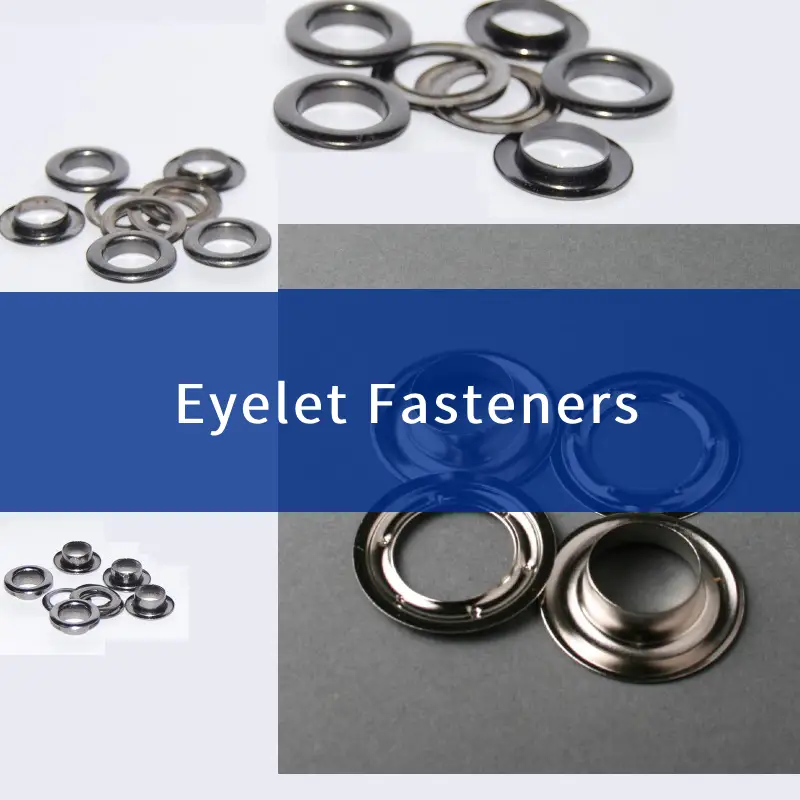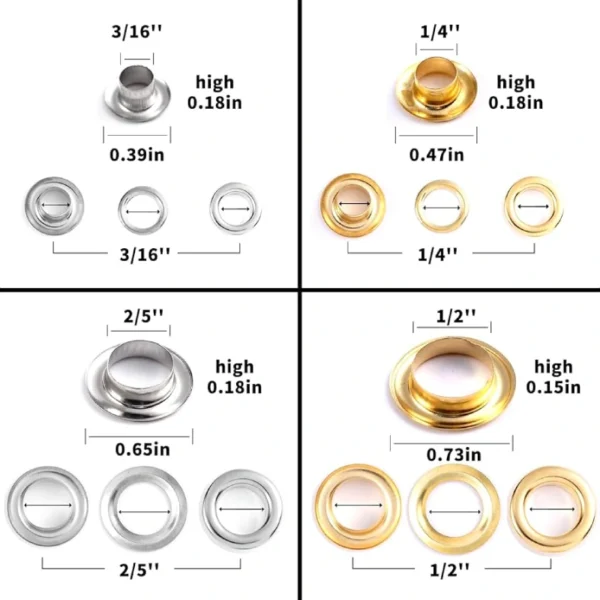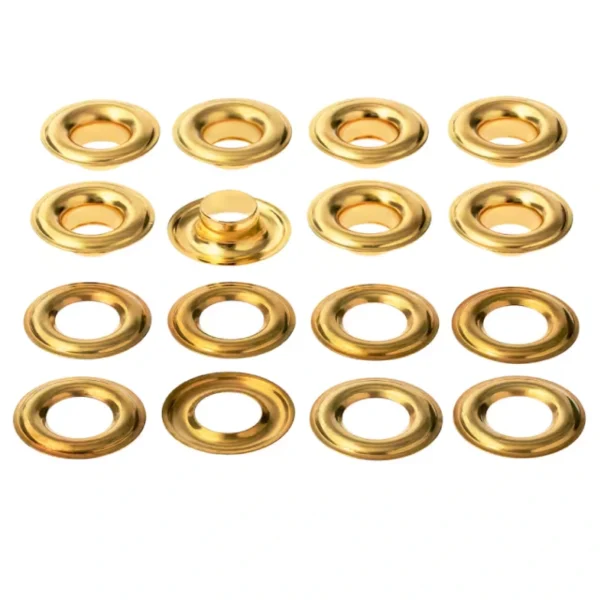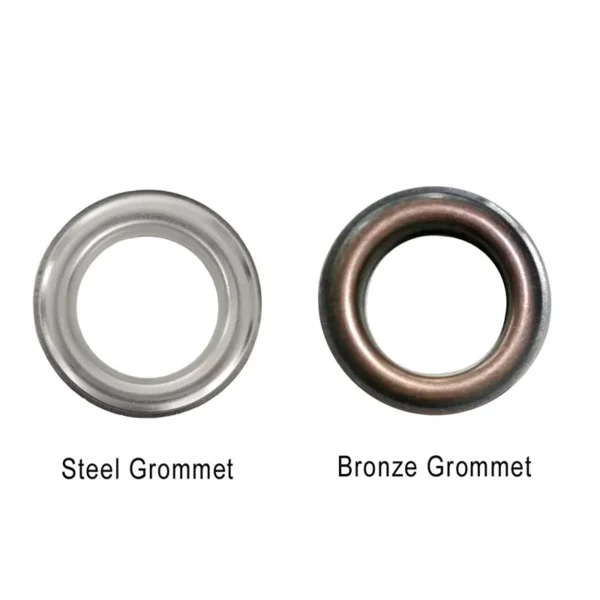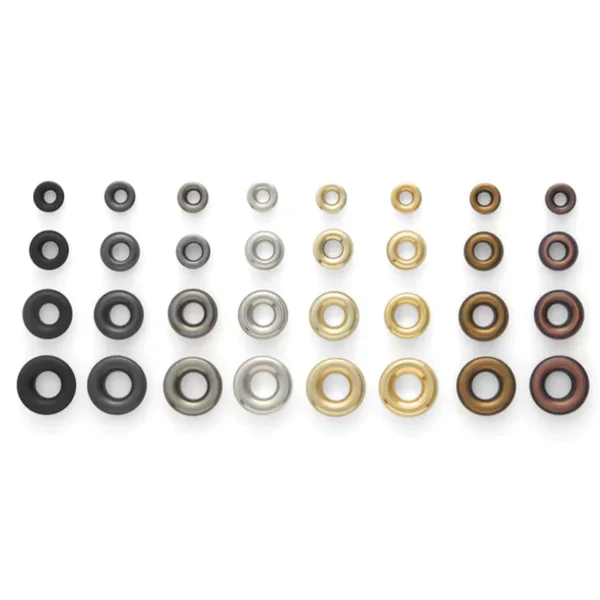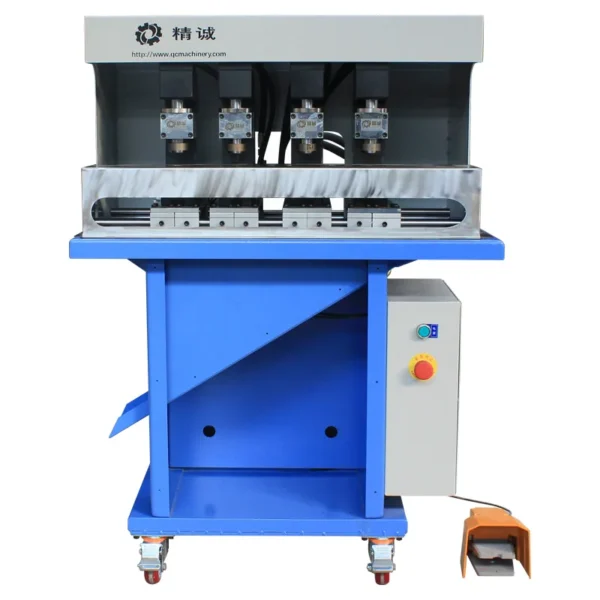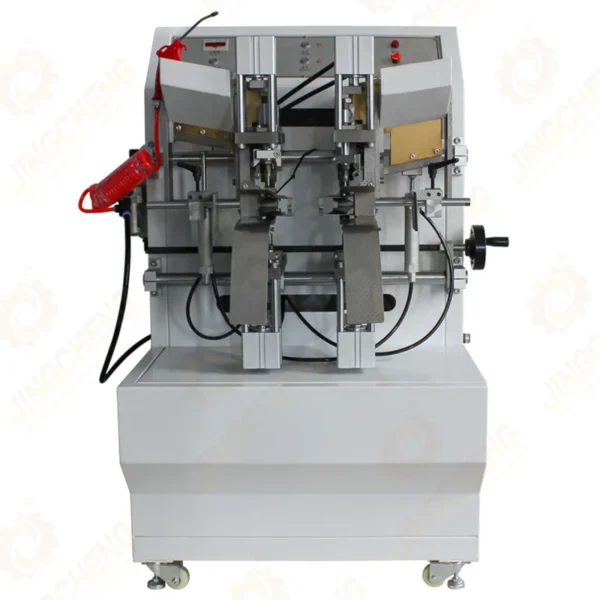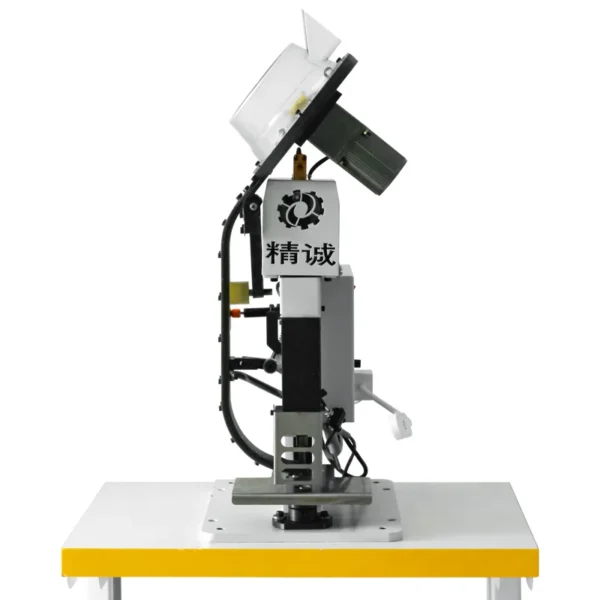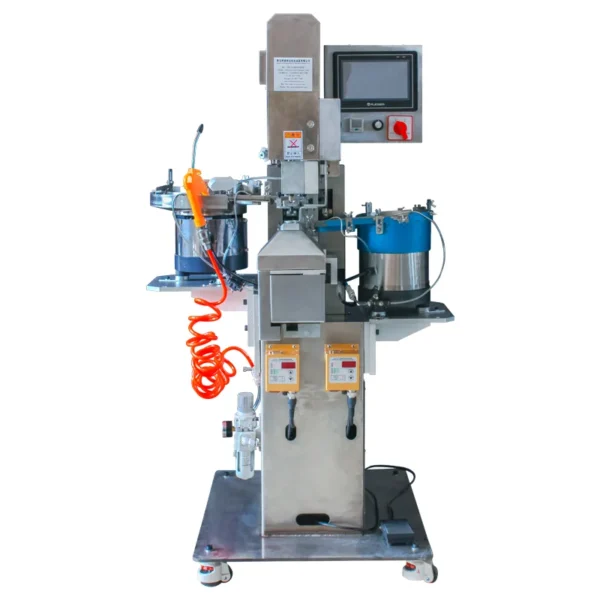Eyelet fasteners are a type of fastening system commonly used in various industries, from fashion to home decor. These small, ring-like metal or plastic pieces are designed to reinforce holes in fabric, leather, and other materials, while allowing cords, laces, or wires to pass through. Eyelet fasteners come in a variety of shapes, sizes, and materials, making them a versatile choice for different applications.
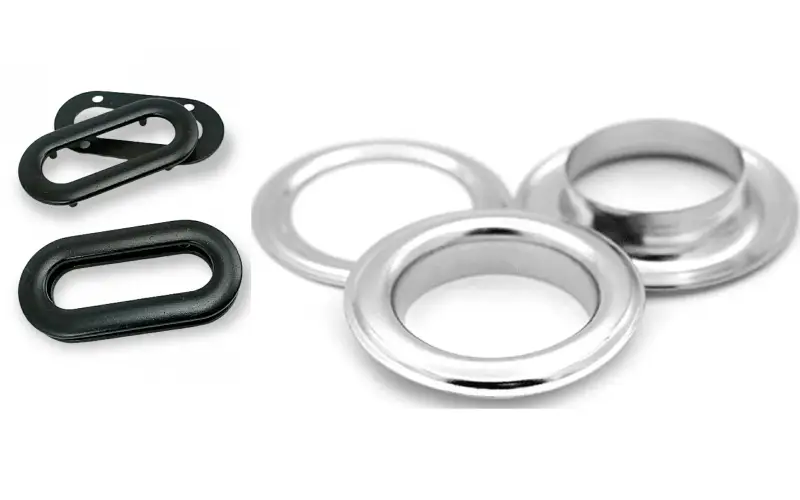
In this guide, we’ll explore what eyelet fasteners are, how they work, their applications in different industries, and the benefits they provide. We’ll also discuss how to choose the right eyelet fastener for your project and provide useful installation tips.
What Are Eyelet Fasteners?
Eyelet fasteners are small, durable rings typically made of metal or plastic, inserted into fabric or other materials to reinforce holes. They help prevent tearing and provide a clean, finished look to any project. These fasteners are commonly used to attach laces or cords, especially in items such as shoes, clothing, bags, and curtains.
Functionality and Applications
Eyelet fasteners work by creating a strong and secure hole in the material, often reinforced by the surrounding ring. This reinforcement helps to extend the lifespan of the material by preventing damage from stress or abrasion. They also provide a neat and professional finish to a hole, which can be aesthetically important in fashion and design.
Types of Eyelet Fasteners
Eyelet fasteners come in various types, each suited for different uses and materials. Understanding the differences between these types can help you make the best choice for your specific application.
Metal Eyelets vs. Plastic Eyelets

- Metal Eyelets: These are the most common type of eyelet fastener and are favored for their durability, strength, and resistance to wear. They are typically made from brass, aluminum, or steel and are ideal for heavy-duty applications such as clothing, shoes, and banners.
- Plastic Eyelets: Plastic eyelets are lighter and more flexible, making them a great choice for lighter fabrics or projects where weight is a concern. While they may not have the same strength as metal, plastic eyelets are often more cost-effective and are widely used in DIY projects, apparel, and accessories.
Other Variations of Eyelet Fasteners
- Rubber Eyelets: Often used in more industrial applications, these eyelets are flexible and provide a good seal in environments where weather resistance or moisture protection is needed.
- Grommets and Washers: While similar to eyelets, grommets and washers are often used together for added reinforcement. These are common in applications that require extra strength, such as in banners or heavy-duty tents.
How Eyelet Fasteners Work

The primary function of an eyelet fastener is to reinforce a hole in a material to prevent it from tearing under stress. Eyelets can also serve as decorative elements, adding to the overall design of the product.
Installation Process Explained
Installing eyelet fasteners requires a simple process that typically involves:
- Punching a hole in the material at the desired location.
- Inserting the eyelet through the hole.
- Setting the eyelet using a hammer or an eyelet-setting machine, which presses the ring securely onto the material.
Eyelet Fasteners in Different Industries
Eyelet fasteners are widely used across various industries, each with its unique applications and requirements. Understanding their roles in different sectors can help you choose the best type for your needs.
Eyelets in Clothing
In the fashion industry, eyelets are often used in garments like shoes, jackets, and pants. They allow for the insertion of laces or cords, providing both functional and decorative purposes. Metal eyelets, in particular, are used for their strength and ability to withstand tension from laces or drawstrings.
Eyelets in Accessories
Eyelet fasteners are also popular in accessories such as bags, belts, and hats. They help reinforce holes used for straps, handles, or decorative elements. Plastic or metal eyelets are commonly used depending on the material and desired durability.
Materials Used in Eyelet Fasteners
The materials used for eyelet fasteners significantly impact their durability, strength, and cost-effectiveness. Here are the most common materials:
Common Materials: Metal, Plastic, and Rubber
- Metal: Eyelets made from metals like brass or stainless steel are the most durable and are used for heavy-duty applications.
- Plastic: Lightweight and flexible, plastic eyelets are used in lighter fabrics and for decorative purposes.
- Rubber: Ideal for moisture-resistant applications, rubber eyelets provide flexibility and protection in outdoor and industrial settings.
Advantages of Metal Eyelets
Metal eyelets offer superior strength and durability, making them perfect for heavy-duty applications. They are resistant to wear and tear, rust, and corrosion, ensuring longevity even under harsh conditions.
Benefits of Plastic and Rubber Eyelets
Plastic eyelets are cost-effective and offer a high degree of flexibility, making them ideal for DIY projects. Rubber eyelets provide excellent weather resistance and flexibility, making them a top choice for outdoor and industrial applications.
Benefits of Using Eyelet Fasteners
Eyelet fasteners provide several benefits that make them an essential component in various projects and industries.
Improved Durability
The primary benefit of eyelet fasteners is their ability to reinforce holes, preventing fabric from tearing or stretching. This makes them especially important in high-stress areas where durability is key.
Aesthetic and Functional Benefits
Eyelets can also add an aesthetically pleasing element to a project. They come in various finishes and sizes, allowing designers to use them as part of the overall look. Additionally, eyelets can function as both decorative elements and practical reinforcements.
The Role of Eyelets in Reinforcement
Eyelets play a crucial role in strengthening materials, especially fabrics. They provide a solid, secure anchor for cords or laces and prevent the material around the hole from deteriorating over time.
Choosing the Right Eyelet Fastener

Selecting the appropriate eyelet fastener depends on several factors, including material type, size, and strength requirements. Here are some things to consider when choosing eyelets:
Factors to Consider: Material, Size, and Strength
- Material: Choose eyelets made of metal, plastic, or rubber depending on the strength, flexibility, and aesthetic requirements of your project.
- Size: Ensure that the eyelet size matches the hole diameter and the material’s thickness for optimal performance.
- Strength: For heavy-duty applications, metal eyelets are preferable due to their durability. For lighter uses, plastic eyelets may suffice.
How to Measure for Eyelets
When measuring for eyelets, consider the thickness of the material and the required diameter for the hole. This ensures that the eyelet fits securely and provides maximum strength.
Installing Eyelet Fasteners
The installation process for eyelet fasteners can be done manually or with the aid of machines.
Tools Needed for Installation
To install eyelet fasteners, you’ll need an eyelet punch, a setting tool, and a hammer or press machine. For larger volumes, an automatic machine is recommended for quick and consistent results.
Manual vs. Machine Installation
Manual installation is often sufficient for small projects, but Eyelet machine installation offers greater speed and precision. Machine installation is ideal for high-volume production and large-scale projects.
Eyelet Fastener Applications
Eyelet fasteners are versatile and can be used in a wide range of applications.
Using Eyelets in DIY Projects
Eyelets are commonly used in crafts and DIY projects such as scrapbooking, jewelry-making, and home decor. They add a professional touch and can be used to reinforce holes for ribbons, cords, and other decorative elements.
Common Problems with Eyelet Fasteners
While eyelet fasteners are durable, they can sometimes experience issues such as loosening or rusting.
Dealing with Loose or Stuck Eyelets
If an eyelet becomes loose, it can be re-set with the proper tools. If it becomes stuck, gently tap it with a hammer to release it. For rusted eyelets, consider replacing them with newer, corrosion-resistant ones.
Eyelet Fastener Trends
Recent trends in eyelet fasteners have introduced new materials, colors, and designs that cater to modern aesthetics.
New Materials and Designs
Innovations in materials like eco-friendly plastics and decorative metal finishes are becoming increasingly popular, offering more options for designers and manufacturers.
FAQs
1. What is the main function of eyelet fasteners?
Eyelet fasteners reinforce holes in fabric or materials, preventing them from tearing and allowing cords, laces, or wires to pass through securely.
2. Can I use plastic eyelets in heavy-duty applications?
While plastic eyelets are flexible and cost-effective, they are not as durable as metal eyelets and may not be suitable for heavy-duty use.
3. How do I install eyelet fasteners?
Eyelet fasteners can be installed manually with a hammer or with the use of a machine for larger projects. The process involves inserting the eyelet through a punched hole and setting it securely.
4. What are the benefits of metal eyelets?
Metal eyelets are strong, durable, and resistant to wear and corrosion, making them ideal for heavy-duty applications such as shoes, banners, and jackets.
5. Are eyelet fasteners used in home decor?
Yes, eyelet fasteners are often used in curtains, drapes, and other home decor items to allow for hanging and adding a decorative touch.
6. How do I choose the right size eyelet?
When choosing eyelets, consider the material’s thickness and the hole’s diameter. The eyelet should fit snugly and provide a secure reinforcement.
Conclusion
Eyelet fasteners are an essential component in a variety of industries, from fashion to home decor. They provide functional reinforcement while also adding aesthetic value to a project. By understanding the different types, materials, and installation processes, you can ensure that you select the right eyelet fastener for your needs.

